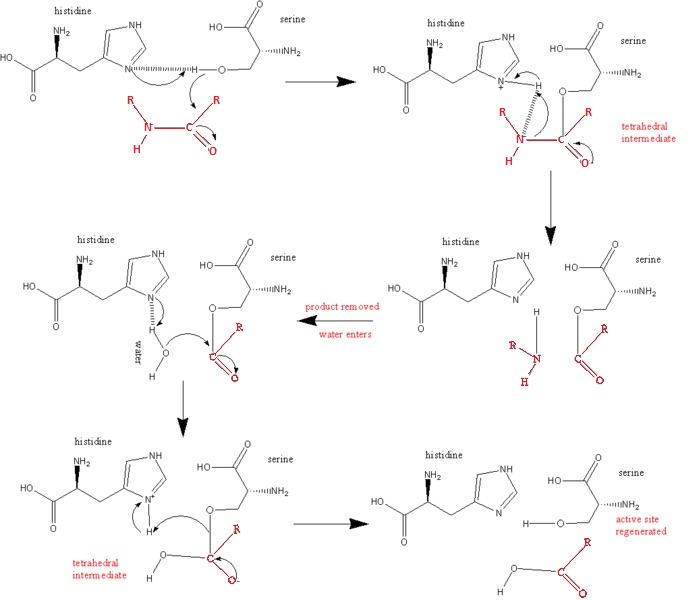Sandbox Wabash13
From Proteopedia
(Difference between revisions)
| Line 6: | Line 6: | ||
'''Trypsin''' is a serine protease released by the pancreas and secreted into the duodenum that acts as a digestive enzyme that catalyzes the hydrolysis of peptide bonds, specifically for positively charged residues (K, R, H). The catalytic mechanism in which the enzyme acts as a protease is as follows: | '''Trypsin''' is a serine protease released by the pancreas and secreted into the duodenum that acts as a digestive enzyme that catalyzes the hydrolysis of peptide bonds, specifically for positively charged residues (K, R, H). The catalytic mechanism in which the enzyme acts as a protease is as follows: | ||
| - | 1. Nucleophillic and base catalysis by enzyme to substrate to form tetrahedral intermediate at carbonyl group of scissile peptide. | + | 1. Nucleophillic and base catalysis by enzyme to substrate to form tetrahedral intermediate at carbonyl group of scissile peptide. The nucleophilic attack is carried out by Ser 195, by attacking the |
| + | scissile peptide's carbonyl group to form the tetrahedral intermediate. | ||
2. Acid catalysis breaks the tetrahedral intermediate through cleaving of the scissile peptide bond to form an acyl-enzyme intermediate. | 2. Acid catalysis breaks the tetrahedral intermediate through cleaving of the scissile peptide bond to form an acyl-enzyme intermediate. | ||
| Line 32: | Line 33: | ||
<scene name='72/725338/Serine__195/1'>Serine 195 - Base Catalysis Residue</scene> | <scene name='72/725338/Serine__195/1'>Serine 195 - Base Catalysis Residue</scene> | ||
| - | Ser 195 nucleophilically attacks the scissile's peptide's carbonyl group | + | '''Ser 195 nucleophilically attacks the scissile's peptide's carbonyl group''' |
<scene name='72/725338/Histidine_57/1'>Histidine 57 - Acid Catalysis Residue</scene> | <scene name='72/725338/Histidine_57/1'>Histidine 57 - Acid Catalysis Residue</scene> | ||
| + | '''The N3 of His 57 donates a proton (General Acid Catalysis)''' | ||
<scene name='72/725338/Aspartic_acid_102/1'>Aspartic Acid 102 - Important Residue in Stabilization of Catalytic Mechanism</scene> | <scene name='72/725338/Aspartic_acid_102/1'>Aspartic Acid 102 - Important Residue in Stabilization of Catalytic Mechanism</scene> | ||
Revision as of 01:24, 19 February 2016
Trypsin Mechanism & Structure - Chase Francoeur, Elias Arellano
| |||||||||||

